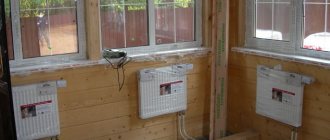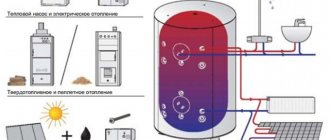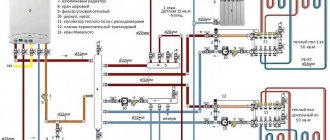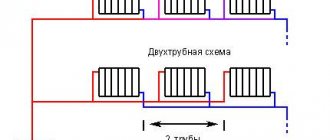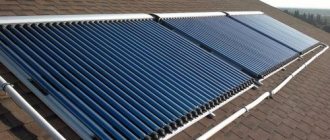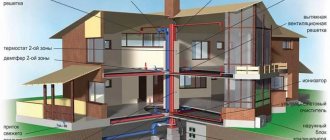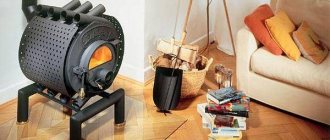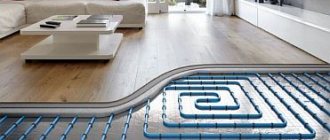Despite its apparent simplicity, competent and correct organization of heating is quite a complex task, especially for non-professionals. If you don’t have the necessary skills, or unexpected surprises in the form of the need to redo the work in the future, contacting specialists in the installation and design of home heating systems will help. We turned to a team of professionals from the Akvahit company to learn about all the subtleties and nuances associated with the installation of a heating system. Therefore, you first need to decide whether it is worth developing a heating scheme for a private house with your own hands or turning to professionals.
Without specialized education, it is very difficult to carry out calculations and installation. Source nehomesdeaf.org
In general, in order to have high-quality heating at home, you can go in the following ways:
- Contact a specialized service that will carry out both the creation of a heating scheme for a private house by the designer and the installation work;
- Order partial execution of installation work by specialists;
- Get professional advice and install heating in a private home yourself.
Regardless of the option chosen, you should imagine the entire installation process in stages. Even if you don’t have to do anything yourself, it never hurts to monitor the progress of the work being done.
What is home heating?
This is a set of engineering components designed to receive heat, transport it and maximize its efficiency in the desired room, in order to maintain temperature conditions there at a given level. Comprises:
- Converter of stored fuel energy into heat (boiler);
- Coolant transportation systems (pipes)
- Shut-off and control valves (faucets, manifolds, etc.);
- Devices for transferring heat to air or a hard surface (battery, heated towel rail, heated floor).
Sample project for installing a heating system for a private home Source yandex.ru
What is burned in boilers
The choice of boiler is initially made according to the type of fuel from which it extracts thermal energy:
- Gas is a simple and inexpensive heating solution. The use of this type of fuel allows you to fully automate the heating process, subject to high-quality installation and configuration of the equipment;
- Solid fuel is most often used in populated areas where there is no gas pipeline. Used: firewood, briquettes, coal or pellets. These types of boilers have a disadvantage - it is impossible to fully automate the heating process. They require the combustion chamber to be filled manually every 10 hours and a separate place to store the fuel. They also need to be cleaned periodically. An intermediate solution is to use an automatic dispenser - autonomy in this case depends on the size of the bunker. In some cases, it is possible to increase the operating time of the boiler without adding fuel to 5-12 days;
- Electricity is the leader in terms of cost, and at the same time in terms of convenience and environmental friendliness of use. The main advantage of such devices is the ability to fully automate control. Also, such boilers require virtually no maintenance;
- Liquid fuel (gasoline, diesel) is most often used in places where there are no other energy sources. The efficiency of such boilers is about 80%, which makes them relatively economical.
See also: Catalog of companies that specialize in insulating country houses.
Heating system elements
The heating system consists of several components, without the use of which it is impossible to create it.
Watch the video
In this section we will analyze in detail the heating elements, their purpose, technical characteristics and what functional features they have.
Boiler
There are several types of energy source used:
- On gas they are distinguished by significant performance and efficiency. It is advisable to use them if there is access to main gas.
- Diesel engines run on inexpensive diesel fuel processed from petroleum products; the use of waste media (waste oil) is allowed. In this regard, they will be most effective. The disadvantage is the need to place it in a separate ventilated extension. Otherwise, during combustion, the presence of the smell of fuel or combustion products in the home is inevitable.
- Electric ones will be the cleanest in terms of the method of generating heat. But they are not economical and are vulnerable to the regularity of energy supply. Their use is justified when using reserve capacities on alternative fuels.
- Solid fuel can operate on any type of fuel, including coal, firewood, pellets, peat and the like. They are affordable in relation to any type of fuel, characterized by significant heat transfer and low prices.
- Combined ones are capable of using many types of energy carriers - gas, solid or liquid fuel, electricity. Particularly applicable in areas where there are interruptions in the energy supply.
Heat communication pipelines
Heat is distributed in the house through an internal pipeline that delivers coolant to the radiators in the form of radiators.
In water systems, pipes perform this role. Pipes can be made from various materials:
- Metal pipes - made of low-carbon steel or copper. Their main disadvantage is the limited service life (for steel) and the significant cost of copper.
- Plastic pipes reinforced in various ways. The most commonly used materials are polypropylene or cross-linked polyethylene. In this case, the best performance is achieved by using pipes reinforced with solid aluminum. Their durability is, according to manufacturers, up to 50 years. In addition, the use of metallization increases the service life of other steel heating parts by blocking the access of atmospheric oxygen to the coolant.
In the currently fashionable heated floors, plastic pipes are used in a coiled design, which makes it possible to make seamless joints. Repairing a pipeline hidden in the floor involves performing a significant amount of construction work when replacing or repairing a heated floor.
The individual circuits of the heating system are combined into a single adjustment and control center, called a manifold.
Radiators for heating system
Of course, the main attention is paid to radiators, through which heat is transferred to the surrounding space. Therefore, the main focus is on the thermal conductivity of the material and the exchange surface area. Radiators are:
- The classic option is cast iron radiators, well known to everyone since Soviet times. They are durable and not at all demanding on the quality of the coolant. But their disadvantage is low thermal conductivity. Cast iron batteries will heat up to 40 degrees on the outer surface only when the water temperature is at least 70 degrees.
- Aluminum radiators have become a popular type. This material has good thermal conductivity and products made from it are very effective. The disadvantage of aluminum radiators is the significant requirements for cleanliness of the coolant. The presence of contaminants in it quickly renders the device unusable. Therefore, in thermal systems it is necessary to use various filters, which leads to a noticeable increase in costs. For such radiators high pressure is unacceptable, so they are not used in industry.
- Steel radiators are widely used due to their significant efficiency. They come in panel and tubular types. Steel products will be one of the most budget-friendly options, while they look quite aesthetically pleasing, which explains their wide distribution. The service life is about 25 years, which is considered a good indicator. At the same time, tubular steel radiators are considered a premium product.
- Bimetallic heating radiators have very high efficiency, which is due to the use of aluminum along with steel in the design. Despite all their positive qualities, their use is limited by their high cost.
- Copper radiators are perhaps the most effective in terms of functional qualities. They do not create resistance to the flow of coolant, due to the high thermal conductivity of copper, and transfer heat to the atmosphere to the maximum extent. They effectively resist hydraulic shock. The only significant drawback is their high cost.
- Following the dictates of the times, radiators are also made from plastic. These are quite nice and effective products at a budget price and durable. Traditionally, given the characteristics of the material, there are significant restrictions - the water temperature should not exceed 80 degrees.
Autonomous radiators
Such radiators operate from the electrical network and are used to maintain a certain microclimate in a hotel room. Can be wall or floor. The body of such a radiator is filled with oil.
A recent addition to the ranks of heating devices is represented by quartz devices. They are made from an alloy of nickel and chromium (nichrome), which has high resistance and therefore heats up when current passes. The heating element is hermetically packed in a housing made of sintered quartz sand.
Expansion tank
It is a regular container, the volume of which should be about 10% of the total amount of water in the pipeline. When the boiler starts, the liquid heats up, and therefore its volume increases. Therefore, the capacity that must accommodate this increase is used.
Heating circuits can be open or closed. In the first case, there is no lid on the tank, which allows the liquid level to change freely. It is logical to install it at the highest point of the heating distribution and its usual location is in the attic.
In addition to compensating for the volume of coolant, the open-type expansion tank serves to release air from the pipeline. With this arrangement of the container, significant heating of the coolant in the tank is inevitable, and consequently its intensive evaporation. In such a situation, this device will become the only place that needs to be used to add liquid.
In closed-type schemes, the expansion tank is sealed and can be installed anywhere in the heating network. The optimal option is to place it in the boiler room, where all other equipment is installed. Sealed membrane tanks are used here.
However, recently it has become common to install additional expansion tanks. For example, the system works more reliably if such a device is mounted on the boiler.
This reduces the overall load on the heating network. An additional tank is also installed in close proximity to a heat source, which in some cases is located in the kitchen inside the house. With this arrangement, the tank is mounted under the ceiling. Not very aesthetically pleasing, but reliable.
Circular pumps
These units are used to create forced circulation of coolant through the pipes of the heating system. Their purpose is to accelerate its passage, which contributes to increased heat transfer.
When using circular pumping stations, the adjustment process in the heating network is simplified and there is no need to place the fuel boiler at the lowest point of the distribution.
The created pressure must have sufficient power to overcome the hydraulic resistance of heating elements - pipes, radiators and other obstacles.
Pumps come in two modifications - dry and wet. In residential construction, wet type units are used. They operate almost silently, which allows them to be installed directly in a residential building.
When designing multi-circuit heating circuits, the use of a pump is provided for in each individual branch.
If repairs are necessary, a bypass is provided, allowing coolant circulation without the participation of a pumping station. This allows you to quickly replace a failed unit with a new one.
The service life of modern circular installations is comparable to this indicator for a heating system.
Shut-off and control equipment
The following are used as such:
- Ball valves for shutting off the flow of coolant through pipes. They are used in two positions – “closed” and “open”; they are not used to regulate the flow.
- Control valves to control the flow force in pipes. Usually located on the return pipe. They can operate in manual and automatic mode based on a signal from a temperature sensor. For this purpose, cranes operating by electric drive are used.
- Specially designed taps for bleeding plugs from heating lines. They can work independently, releasing the air plug as it forms.
Protective devices
In the heating system circuits they are represented by pressure valves and temperature sensors. The first ones are used mechanically and do not use any energy in their work.
They are triggered when the pressure is exceeded (in the boiler, boiler), opening a discharge when it is exceeded.
Thermal sensors and thermostats are triggered when the temperature rises critically, turning off the heating device or giving a signal to the automatic control system to turn on the addition of cold water.
Video description
Comparison of fuel types in this video:
If there is no gas - pellet boilers BIODOM
If gas is supplied to the house, then it is almost guaranteed to be the optimal heating solution. But if there is no gas, even if there is a central highway nearby, then a prudent owner will consider not only the cost of heating, but will also add in the cost of connecting a gas pipeline to the house. In this case, pellet boilers look more economically profitable. Moreover, there are now innovative solutions on the market to automate their work.
It would seem that the evolution of pellet boilers stopped in the early 2010s, when manufacturers introduced screw feeding technology, which made it possible to significantly simplify the management of the home heating system. Everything that manufacturers have come up with in recent years was more like complicating the boiler for the sake of the complication process itself, rather than helping the boilers themselves become better and more efficient.
It seemed that it was impossible to improve the efficiency of pellet combustion and simplify the process of installation, startup and operation of pellet boilers. But in 2022, the BIODOM company appeared on the Russian market with its development - pellet boilers with BIOLOGIC technology. Back in 2004, having developed and patented its invention, this European company, overcoming the difficulties of an unknown brand, brought its know-how to the masses - a pellet boiler, all interaction with which consists of adding pellets and pressing the “Start” and “Stop” buttons.
BIODOM engineers paid a lot of attention to the energy efficiency and cost-effectiveness of the boilers they produce Source biodom-ural.ru
Today, BIODOM boilers with BIOLOGIC technology are time-tested, and invariably, from year to year, they prove their uniqueness and performance. One of the main secrets is the use of solutions used in modern cars and their processing to control the combustion of solid fuel, which has become a unique novelty that has solved most of the problems in the industry.
- Boilers have become compact - space can be allocated for them in a house of any size.
- Installation has become as simple and time-consuming as installing an electric boiler.
- The chimney was reduced to the smallest possible size and became the same as that of a gas wall-mounted boiler.
- Activating a new BIODOM pellet boiler is easier than starting a microwave - after pressing the “Start” button, reliable automation will do the rest, including adjusting for pellet quality.
- The cost of installation and operation is one of the lowest compared to boilers operating on other types of fuel.
Selection of PP heating pipes
Heating systems are created from polypropylene pipes with reinforcement and a layer of anti-diffusion material that blocks the access of oxygen. Therefore, you need to pay attention to the labeling.
PP pipes
If it is necessary to connect a polymer heating circuit to a solid fuel boiler. First, a section at the supply and return with a length of at least 1.5 m made of steel or copper is installed.
How to choose the diameter
Accurate selection of sections and lengths of individual sections of the pipeline system is carried out using hydraulic calculations. If the area of the house does not exceed 250 m², the computational process need not be carried out.
The diameter is selected based on the required total battery power. In this case, the cross-sections of the main pipes and risers will be larger compared to the same dimensions of the inlet and outlet sections near each radiator.
Hydraulic calculation allows you to determine:
- required coolant volume;
- pressure loss in the entire pipeline system and in areas from the boiler or pumping unit to each battery.
To determine the flow rate of heated water, the heat losses of the house are divided by the product of the heat capacity of the coolant and the difference between its temperatures at the outlet and inlet of the heat-generating installation
The speed of water movement is calculated by the ratio of its flow rate in a certain area to the cross-sectional area of the pipeline.
Pressure loss is calculated by multiplying the length of a pipe with the same diameter and the specific friction loss. The last value is taken from reference literature or obtained from the manufacturer.
Resistance losses are calculated for fittings, fittings and equipment. The required value is determined by the product of the density of the coolant, its speed squared, which is divided by two, and a special coefficient indicated by the manufacturing company.
All obtained resistance values are summed up. The result is compared with control values. Error-free hydraulic calculations can be performed by qualified specialists.
Coolant transfer devices
For use as a coolant, a universal solution in terms of price and efficiency would be to use ordinary water. True, such heating systems in private homes will require the installation of additional equipment. It includes the following elements:
- Capacity to compensate for the expansion of liquid when heated (open or membrane type);
- Circulation pump;
- Hydroarrow;
- Buffer tank;
- Collector. Needed if a beam distribution system is used;
- Container for indirect heating;
- Sensors and devices for taking their readings (if automation is used).
Note. The expansion tank is an integral part of the water heating system. It must be installed without fail.
When water is heated, it increases in volume, which in a confined space increases the pressure in the pipes and often provokes their rupture. An expansion tank into which excess water is forced out helps to avoid such consequences.
This is what the expansion tank looks like in the system Source infourok.ru
The circulation pump ensures the movement of coolant through a network of pipes. The use of several pumping units for a large number of circuits is possible due to the installation of a separating hydraulic arrow or a buffer tank, which simultaneously serves as a heat storage tank. The use of such equipment is especially indicated for multi-storey private houses.
Distribution collectors, such as the Gibax G-Collector, are most often installed to power underfloor heating or when connecting radiators using a radial circuit. As for the tank for indirect heating, it is a container with a coil that heats water for hot water supply needs.
Measuring instruments are installed for visual monitoring of temperature and pressure in pipes. To ensure automation of the heating process, pressure sensors, temperature regulators and controllers are installed.
The basis of everything is a plan
Without knowing it, we completed the first point of the work plan - we calculated the required thermal power for heating. The general plan also includes determining the location and number of radiators, selecting pipes and necessary accessories (fittings, taps, manifold distributors, filters and other necessary parts of the heating system). The plan, usually drawn in enlarged form, marks the location of all the elements that a homemade heating system provides, and in addition, it allows you to select heating devices.
Detailed heating plan
As a rule, any radiators will work in a heating system; the only question is how much they cost and what they look like. They are usually located under window openings to provide a thermal curtain. When choosing radiators, you can be guided by a rough estimate - if the coolant temperature is seventy degrees, then one section is used to heat an area of three square meters. m.
After the power of the boiler and radiators has been selected, it is time to choose pipes. The most popular and affordable are polypropylene and metal-plastic. Of course, if you decide to do the heating yourself no matter what, you can use other types of pipes, but the rest of their types are either outdated, require welding and additional operating costs (steel), or very expensive (copper).
Metal-plastic pipes
Types of batteries by shape and material
There are various types of heating devices on the market, each of which has its own design features and characteristics. When installing heating in a private home, an important condition for the correct operation of the entire installation is the competent selection of the heating unit.
Properly selected batteries are the key to uniform heating of the room Source zerocreation.ru
The following types are distinguished:
- Sectional batteries made of cast iron. Their disadvantages are bulkiness, unsightly appearance, possible violation of the integrity of the joints between sections, as well as a low degree of heat transfer; In return, they are resistant to pressure changes and have an impressive service life.
- Sectional batteries made of bimetallic materials. The radiator sections are made of light alloy metal, and their inner part is lined with stainless steel. They are distinguished by durability, practicality and aesthetic appearance. Unlike cast iron radiators, bimetallic ones can withstand higher pressure;
- Sectional batteries made of aluminum are made of light alloy metals without the use of steel. They have high thermal conductivity, and the operating pressure is comparable to that of cast iron radiators;
- Panel batteries made of steel. They are non-separable welding structures with decorative cladding and have high heat transfer rates. The disadvantages include low operating pressure, which limits the scope of application.
- A convector is a pipe with fins designed for the same pressure as in the main pipelines.
Important! The use of steel pipes for hidden installation of liners is strongly discouraged. It is also prohibited to join different materials together - a common mistake is connecting copper pipes to aluminum radiators.
The pipelines through which the coolant enters the heating devices can be made of polymer and combined materials, copper or steel. For example, you should pay attention to Gibax metal-plastic pipes. In addition to resistance to pressure and temperature, these pipes are resistant to chemicals, have a 10-year warranty from the manufacturer, and a service life of more than 50 years.
Pipelines and splitters made of various materials Source kvadro72.ru
Recommendations for choosing a boiler
At the moment, there are various types of heating, characterized by the energy carrier or type of fuel used. Which one to choose is up to you, and we will present all types of boilers with a brief description of their pros and cons. To heat residential buildings, you can purchase the following types of household heat generators:
- solid fuel;
- gas;
- electrical;
- on liquid fuel.
The following video will help you choose an energy carrier, and then a heat source:
Video description
In our video we’ll talk about heating in a private country house.
Our guest is the author and presenter of the Teplo-Voda channel Vladimir Sukhorukov: Safety is an absolute advantage of a water heating system. But besides the positive aspects, it has disadvantages:
- The difficulty of heating large rooms due to significant heat loss during the circulation of coolant through the pipes;
- Additional costs for hiding an extensive network of pipes and heating devices under the cladding to preserve the aesthetics of the appearance of the rooms;
- Large battery dimensions;
- Possible problems may arise after draining the coolant from the pipes, in the form of air plugs.
What a thermal imager shows if there is air in the sections Source zerocreation.ru
DIY water heating of a private house, design diagrams
When independently building a country house, everyone wondered how to make water heating at home with their own hands, and looked everywhere for diagrams of possible designs. Today there are many different options for installing water heating home systems. They can be easily divided into just three main types. The equipment and materials used for all of them are the same, but the design is different. What are the main differences and what are the advantages of each system?
A properly installed heating system is the key to comfort in your home during cold weather.
Fluid circulation methods
The coolant moves through the pipes by gravity (convection and expansion), or by forced means. In the first case, the liquid heated in the boiler, due to convection, moves through a network of pipes to the radiators. This movement of water is called direct current. Next, the coolant cooled in the batteries moves back to the heating boiler, after which the cycle is repeated. This segment is the reverse current.
To increase the circulation rate of the heat carrier through the pipes, specialized pumping units are used that are installed between the return flow pipes. There are models of heating boilers with built-in pumps.
Natural way of circulation
The coolant moves here naturally, without the application of extraneous forces. It uses the simplest physical principle, thanks to which water is heated in a kettle, and this happens because its hot layers are lighter than cold ones and rise to the top.
An example of natural coolant circulation Source santehnika-nk.ru
This is how the whole process happens - the water heated in the boiler rises to the highest point of distribution and then moves by gravity under the influence of its own weight (the pipes are at a slope of 3-4 degrees). Passing through the batteries, the water cools, its density increases, and when it enters the heating boiler, it displaces the already heated layers to the top.
Heating systems based on this type of circulation are quite simple and do not require the installation of additional equipment, which simplifies the installation process. But they are only suitable for houses with a small area due to restrictions on the contour length of 30 meters. Also, the disadvantages include the need to install pipes with a large diameter and low pressure levels.
How to turn all the individual parts into a heating system
Once all the components of the system have been identified, they must be assembled into a single whole. Therefore, when installing a heating system with your own hands, you need to choose the method in which it will be done. There may be several of them. It is worth noting that one of the differences between them will be the method of coolant circulation - natural (gravitational) or forced. An option, as an example, of how you can install heating yourself, is shown in the photo:
Heating system with forced circulation of coolant
1. With natural circulation, no additional devices are needed, it is the simplest and is completely autonomous; it does not even require a power supply for its operation. The disadvantages of such a system include the small size of the heated area and compliance with a number of mandatory requirements during its installation.
To carry out forced circulation, a pump is used to pump water.
Such an organization of heating operation is considered universal and can be designed to heat any area, but is more expensive. This is due to the need to use equipment and pipes operating at high pressure, and therefore more expensive safety valves, as well as to use an additional pump and an emergency power source for its operation.
2. In addition to determining how the coolant will circulate, a diagram must be determined according to which the elements of the future heating system will be connected. It can be two-pipe or single-pipe. The latter differs in that the water passes one radiator after another, giving up some heat in each of them. Therefore, the degree of heating of the last of them may be lower than the first. By the way, such a system is shown in the photo above.
Do-it-yourself heating in the country
With a two-pipe installation scheme, water is supplied directly to each radiator from the main line and also goes into the common main after passing through the battery.
3. When you have made the decision to do the heating yourself, you need to take into account one more feature when choosing a heating system. It can be closed or open. In the latter case, the coolant is in contact with the atmosphere, whereas when using a closed system this is excluded.
Additionally, information about the heating system is provided by a video explaining certain aspects of doing this work on your own.
Mistakes made during installation
The most common mistakes when performing calculations or installing heating are:
- Incorrect determination of the required boiler power;
- Incorrect strapping;
- Illiterate choice of the heating scheme itself;
- Incorrect installation of all elements.
Insufficient boiler power is the most common error. It occurs when, during the selection of a heat generator for heating and hot water supply needs, the necessary additional power for heating water is not taken into account.
Incorrect selection of heating scheme leads to additional costs for reworking the entire structure. This mistake is made when installing a single-pipe distribution with more than 6 radiators. A large number of batteries does not allow them to warm up.
The last heating elements in the chain will always remain cold Source interistroy.ru
Also, during installation, the slopes of the pipelines are not observed, pipes of poor quality are connected, and inappropriate additional equipment is installed.
When installing heated floors, the pipes must be insulated in order to avoid heat loss on the way to the heating “snail”.
A common mistake when connecting pipelines is exceeding the exposure time of the soldering iron to the pipes required to obtain a reliable joint. As a result, their internal diameter decreases and a bottleneck is formed.
Diagrams by type of coolant supply
The radiator will work effectively if the coolant is evenly distributed across all sections.
Warm and cold water have different densities. The heated coolant always tends upward. In the system it is replaced by cold, denser water. This feature is taken into account when supplying coolant to the batteries.
Coolant supply diagram
Upper eyeliner
Each radiator has vertical channels connecting the horizontal upper and lower manifold. The presence of these elements allows the coolant to circulate in the device.
With the top connection, mainly only the top of the battery heats up. To prevent such an effect, a jumper is installed after the first rib in the direction of flow of the coolant. Therefore, the heated water first falls into the lower collector.
Then it passes through all sections of the radiator and enters the return pipeline. As a result, the top connection turns into a diagonal way to connect the battery.
If there is no jumper in the radiator, the supply pipe is connected at the top, and the return pipe at the bottom from the opposite end of the battery. This option is called diagonal strapping.
Bottom eyeliner
This is the easiest way to tie. The scheme involves installing the boiler in the basement or on the ground floor. From the heat generating unit, the main pipeline is led to the attic, where the expansion tank is installed. A starting line is laid from the tank, but not lower than 1.5 m to the first radiator.
The supply and return are connected to the batteries at the lowest points on opposite sides. All radiators in the system are connected to pipelines in the same way and installed in series.
When installing a heating circuit with natural circulation, the pipes are laid at an angle. The last battery must be located above the boiler. The height difference between the final radiator and the heat generating unit should not exceed 3 m.
Connection in progress:
- circulation pump;
- bypasses;
- shut-off valves;
- Mayevsky cranes.
Pumping equipment runs on electricity. When it is turned off, circulation of the coolant is possible only in a natural way. Therefore, it is better to lay pipelines at a slope.
Boiler connection
It should be noted that the wiring of gas, diesel and electric heat generators is almost the same. Here we must take into account that the vast majority of wall-mounted boilers are equipped with a built-in circulation pump, and many models are equipped with an expansion tank. First, let's look at the connection diagram for a simple gas or diesel unit:
The figure shows a diagram of a closed system with a membrane expansion tank and forced circulation. This tying method is the most common. The pump with a bypass line and a sump tank is located on the return line, and there is also an expansion tank there. The pressure is controlled using pressure gauges, and air is removed from the boiler circuit through an automatic air vent.
Note. Piping an electric boiler that is not equipped with a pump is carried out according to the same principle.
When the heat generator is equipped with its own pump, as well as a circuit for heating water for domestic hot water needs, the pipe layout and installation of elements is as follows:
Shown here is a wall-mounted boiler with forced air injection into a closed combustion chamber. To remove flue gases, a double-walled coaxial flue is used, which is led out horizontally through the wall. If the firebox of the unit is open, then you need a traditional chimney with good natural draft. How to properly install a chimney pipe made of sandwich modules is shown in the figure:
In country houses with a large area, it is often necessary to connect a boiler with several heating circuits - a radiator, heated floors and an indirect heating boiler for DHW needs. In such a situation, the optimal solution would be to use a hydraulic separator. It will allow you to organize independent circulation of coolant in the boiler circuit and at the same time serve as a distribution comb for the remaining branches. Then the basic heating diagram for a two-story house will look like this:
According to this scheme, each heating circuit has its own pump, thanks to which it operates independently of the others. Since coolant with a temperature of no more than 45 ° C should be supplied to heated floors, three-way valves are used on these branches. They add hot water from the main line when the temperature of the coolant in the heated floor circuits drops.
With solid fuel heat generators the situation is more complicated. Their strapping should take into account 2 points:
- possible overheating due to the inertia of the unit; the firewood cannot be extinguished quickly;
- formation of condensation when cold water enters the boiler tank from the network.
To avoid overheating and possible boiling, the circulation pump is always placed on the return side, and on the supply side there should be a safety group located immediately behind the heat generator. It consists of three elements: a pressure gauge, an automatic air vent and a safety valve. The presence of the latter is crucial; it is the valve that will relieve excess pressure when the coolant overheats. If you decide to heat your house with wood, then the following wiring diagram is required:
Here, a bypass and a three-way valve protect the furnace of the unit from condensation. The valve will not allow water from the system into the small circuit until the temperature in it reaches 55 °C. Detailed information on this issue can be obtained by watching the video:
Advice. Due to the nature of their operation, solid fuel boilers are recommended to be used in conjunction with a buffer tank - a heat accumulator, as shown in the diagram:
Many homeowners install two different heat sources in the furnace room. They must be properly tied and connected to the system. For this case, we offer 2 schemes, one of them is for a solid fuel and an electric boiler working together with radiator heating.
The second scheme combines a gas and wood heat generator, supplying heat to heat the house and prepare water for hot water supply:
Why water heating?
The carrier is water, and its heat capacity is 4000 times greater than that of air, and it is one of the cheapest and most accessible resources. But there is, and more than one, fly in the ointment. The installation process cannot be considered simple, and if you plan to install a gas boiler, then you need the appropriate permit, plan, etc. In addition, work can only be carried out at the construction stage. And if you need to organize floor heating, then the scheme becomes even more complicated.
Heating the floor of a private house
This type of heating also requires constant monitoring. If you are planning to leave your home for a long period in winter, then the media should be drained. Otherwise, at sub-zero temperatures it will turn into ice and simply rupture the pipeline. Everyone knows that water contains various impurities that contribute to the corrosion of metal elements that any system contains. And salt deposits on the inside of the pipes prevent free flow and impair heat transfer. And finally, if a special bleeder valve is not installed, air locks may occur in the system. They also significantly reduce efficiency.
Balancing methods
The setup procedure at home can be done in two ways:
according to the calculated coolant flow using an electronic flow meter; Approximate temperature balancing.
The first method is the most accurate and requires the availability of a design and hydraulic calculation of the system indicating the water flow at each section of the pipeline. Without this, fine tuning of the system is impossible. In extreme cases, you can do the calculation yourself or contact a specialist in this field. The second component is control valves installed on each branch or riser. And third, a special electronic device for balancing, connected to the corresponding fittings.
The essence of the method is to use the device to determine the real coolant flow rate on each branch or riser of the system. To do this, a balancing valve with fittings for connecting the electronic unit must be installed on the return line branch. Having in hand a diagram with the indicated flow rates for each branch, all that remains is to connect the device to the valve fittings and adjust the required flow rate by turning the spindle. The heating system of a multi-storey building is also balanced in this way.
When everything is designed and calculated correctly, all batteries located on an adjusted riser or branch will receive the required amount of heat. It is not customary to configure each heater using this method, especially if it is equipped with a thermostat.
5
How to arrange heating at home - advice from professionals
The devices and methods for adjusting the heating system described above significantly increase the efficiency and safety of its operation. It would be useful for the owner to know the rules for installing some individual network elements that directly affect the quality of its functioning. Battery adjustment begins at the design stages of a new communication and during the installation process
It is important to choose the right method for connecting radiators, since the type of installation directly affects the efficiency of the device and the further possibility of installing special thermostats
If you want to monitor and regulate the operation of equipment, you must take into account the pipe layout. In single-pipe systems, there is always a jumper or bypass necessary to redirect the flow of hot water in the event of radiator replacement and other repairs. In two-pipe networks, heating elements are connected in parallel to each other, so it is much easier to regulate the temperature of the batteries.
Heating at home
In a private house, during any heating work, it is necessary to take into account the characteristics and individual characteristics of the installed boiler. The efficiency of the engineering system depends on it. To ensure that the network works correctly and can be easily adjusted, choose a boiler taking into account:
1. Rated power. For 10 m2 of area, about 1 kW of boiler power is required with minimal heat losses.2. The ratio of the power of the heating boiler to the volume of water. To heat 15 liters of coolant, 1 kW of power is needed.3. Permissibility of smooth adjustment of the boiler. Typically, gas boilers have this function.
If you and the hired designers manage to correctly calculate the required boiler parameters, during operation of the heating network it will be possible to regulate the water temperature in the radiators as simply and accurately as possible. A good boiler increases the safety of home engineering and makes the network more reliable and functional. Do not forget to take into account the climatic conditions in your region when making calculations. In the northern regions of Russia, more powerful boilers are required, and in the southern regions, less powerful ones, which make it possible to spend much less money and resources to maintain comfortable temperature conditions in the rooms.
Photo
